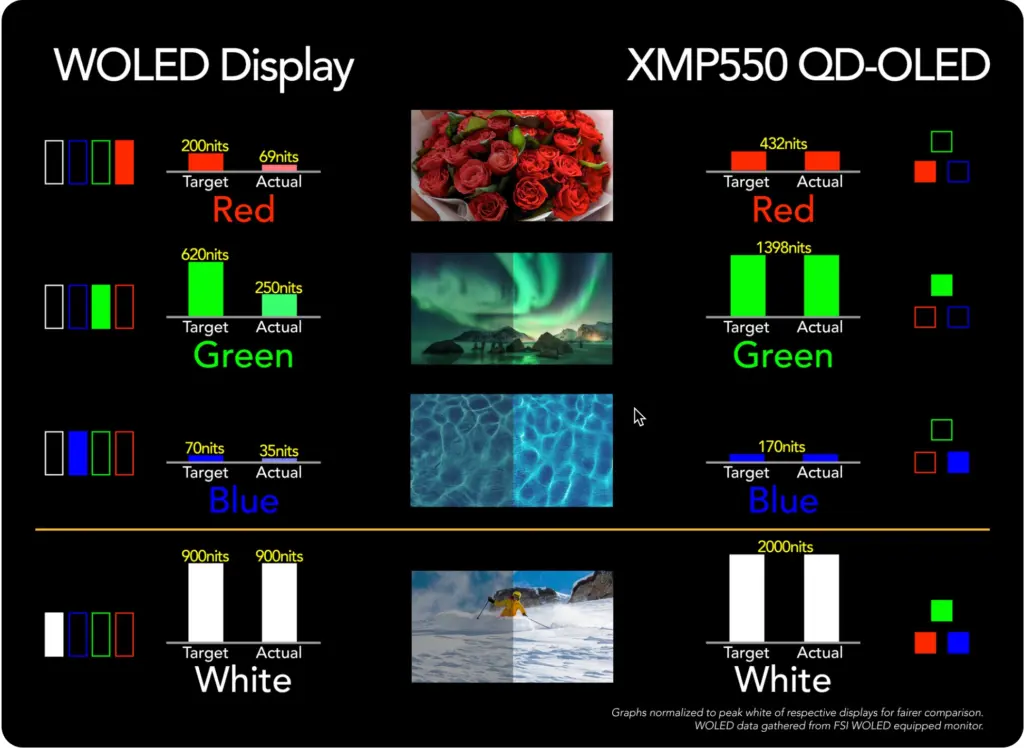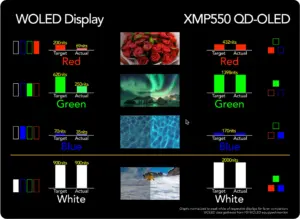When I first saw the performance and specifications for Samsung’s QD-OLED panels, it seemed to me that a natural market for the technology would be the broadcast monitor market. After I spent several days at IFA last year in a private demo suite with color guru Florian Friedrich who showed me a lot of demonstrations alongside Sony’s BVM dual panel grade A monitor, I became even more convinced. Apart from at very high brightness, a Samsung QD-OLED TV looked as good as the $30,000 (approximately) Sony monitor.
However, when I raised the possibility of using the panels in professional monitors with one of the leading brands in that market at last year’s IBC, I heard that the firm was having trouble getting attention from Samsung Display for this application. That has clearly changed now, as I spotted an announcement from the CineGear Expo in LA, that Flanders Scientific Inc. (FSI), a leading brand of broadcast monitors, was launching a 55″ UltraHD monitor, the XMP550 based on QD-OLED. Shipments of the 2,000 cd/m2 unit will start from September at an SRP of $19,995. (against $11,000 for the same size of WOLED monitor from the firm).
Special Inputs and Features
Of course, as a professional monitor, the unit has a range of SDI inputs up to 12G and features such as programmable LUTs. The monitor supports a color gamut well beyond DCI-P3 and has auto-calibration. FSI highlighted the lower power consumption of the monitor compared to dual panel architectures. There are other professional features such as 4K/UHD compatible real-time waveform and vector scopes as well as false color monitoring and integrated markers.

The QD-OLED technology has very good viewing angles, which could make the display a very good one when the content needs to be shared with clients or creatives. It does seem a bit bigger than might be ideal for desktop use, but it is unlikely that Samsung will have wanted to develop a 32″ panel specifically for this application. Further, the 55″ panel with UltraHD has, by my calculation, a ppi rating of 80 while the 34″ monitor that is sold by Dell and others is around 110ppi. Taking that to UltraHD on a 32″ could move the pixel density up to 138pp.
As far as I know, there is no hard limitation on the ppi of QD-OLED technology, but there is an ink jet process to deposit the QDs, so it could be that higher dot density is a challenge. Even if it is not, making another size would mean new masks and possible cutting inefficiencies, although it strikes me that a 32″ UltraHD desktop QD-OLED monitor would be an attractive option for many users. (I’d certainly be saving up to get one!).
Power
The dual panel monitors from Sony, Eizo and others are, as well as being expensive, are very power hungry as the aperture ratio will be extremely low. For a professional application, the cost of this is unlikely to be an issue, but reducing power consumption is always a good idea, especially if the monitor is used on location.
The Sony BVM-HX310 uses around 450W while the XMP550 uses from 75W to 325W (as it’s emissive, the consumption will vary with APL, whereas the dual panel monitors have a fixed backlight). The display can support 20% of the screen at 2,000 cd/m2 while the Sony BVM-HX310 can support 1,000cd/m2 for the whole display. (At NAB this year, Sony showed a new version, the BVM-HX3110, can produce 4,000 cd/m2 over the whole display area although the power consumption was ‘TBA’ at press time).
UltraHD vs DCI 4K
Of course, while the FSI monitor uses a panel that was designed for TV, and so has a resolution of 3840 x 2160 (UltraHD), the Sony monitors support the DCI 4K cinema resolution of 4096 x 2160. That’s a key difference (and one that Display Daily has tried hard to make sure is always noted). DCI-4K panels are made only for professional applications, with much much lower volumes than the UltraHD format, so are always more expensive for the same specification. Again, it would seem unlikely that it would be worthwhile for Samsung to make QD-OLED panels in that format, at least for the moment.
If there is any kickback against this monitor, it’s about the pricing. After all, 55″ Samsung TVs with this panel are as cheap as $1,299 at press time (and that is a ridiculously good bargain!). The extra $18,700 seems an awful lot for the ‘professional’ chassis!

Footnote: I have to apologize, this article was delayed as a correspondent was heading for the CineGear Expo and we were hoping for some feedback. Unfortunately, the suppliers of lighting were producing so much ambient colored light, it made it very difficult to properly judge the XMP550.
Bob Raikes is semi-retired from the display industry, but still edits the 8K Association newsletter and contributes to Display Daily.

